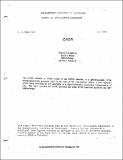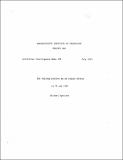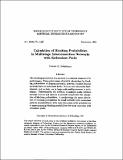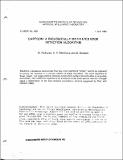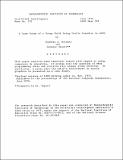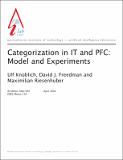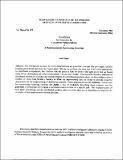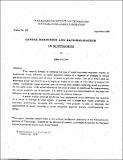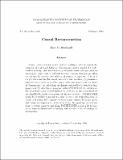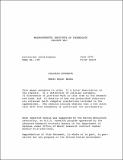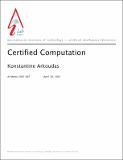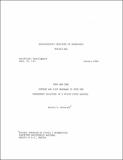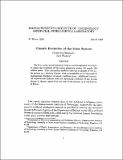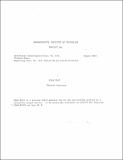Browsing AI Memos (1959 - 2004) by Title
Now showing items 91-110 of 1217
-
CADR
(1979-05-01)The CADR machine, a revised version of the CONS machine, is a general-purpose, 32-bit microprogrammable processor which is the basis of the Lisp-machine system, a new computer system being developed by the Laboratory ... -
The Calcomp Plotter as an Output Device
(1967-07-01)(1)CHAR PLOT (see AI Memo 125) has been modified for TS. [It may be found on MS4 with the non-TS version]. The following changes should be noted: CRKBRK (now called PLTBRK in the non-TS CHAR PLOT), SUBPLT (which is ... -
Calculating the Reflectance Map
(1978-10-01)It appears that the development of machine vision may benefit from a detailed understanding of the imaging process. The reflectance map, showing scene radiance as a function of surface gradient, has proved to be helpful ... -
Calculation of Blocking Probabilities in Multistage Interconnection Networks with Redundant Paths
(1991-12-01)The blocking probability of a network is a common measure of its performance. There exist means of quickly calculating the blocking probabilities of Banyan networks; however, because Banyan networks have no redundant ... -
Capturing Intuitive Knowledge in Procedural Description
(1976-12-01)Trying to capture intuitive knowledge is a little like trying to capture the moment between what just happened and what is about to happen. Or to quote a famous philosopher, "You can't put your foot in the same river ... -
CARTOON: A Biologically Motivated Edge Detection Algorithm
(1982-06-01)Caricatures demonstrate that only a few significant "edges" need to be captured to convey the meaning of a complex pattern of image intensities. The most important of these "edges" are image intensity changes arising ... -
A Case Study of a Young Child Doing Turtle Graphics in LOGO
(1976-07-01)This paper explores some important issues with regard to using computers in education. It probes into the question of what programming ideas and projects will engage young children. In particular, a seven year old ... -
Categorization in IT and PFC: Model and Experiments
(2002-04-18)In a recent experiment, Freedman et al. recorded from inferotemporal (IT) and prefrontal cortices (PFC) of monkeys performing a "cat/dog" categorization task (Freedman 2001 and Freedman, Riesenhuber, Poggio, Miller ... -
CAULDRONS: An Abstraction for Concurrent Problem Solving
(1986-09-01)This research extends a tradition of distributed theories of mind into the implementation of a distributed problem solver. In this problem solver a number of ideas from Minsky's Society of Mind are implemented and are ... -
Causal Reasoning and Rationalization in Electronics
(1978-09-01)This research attempts to formalize the type of causal arguments engineerings employ to understand circuit behavior. A causal argument consists of a sequence of changes to circuit quantities (called events), each of ... -
Causal Reconstruction
(1993-02-01)Causal reconstruction is the task of reading a written causal description of a physical behavior, forming an internal model of the described activity, and demonstrating comprehension through question answering. T his ... -
Causal/Temporal Connectives: Syntax and Lexicon
(1989-09-01)This report elucidates the linguistic representation of temporal relations among events. This involves examining sentences that contain two clauses connected by words like once, by the time, when, and before. Specifically, ... -
Causes and Effects of Chaos
(1990-12-01)Most of the recent literature on chaos and nonlinear dynamics is written either for popular science magazine readers or for advanced mathematicians. This paper gives a broad introduction to this interesting and rapidly ... -
Cellular Automata
(1970-06-01)This paper presents in order 1) a brief description of the results, 2) a definition of cellular automata, 3) discussion of previous work in this area by Von Neumann and Codd, and 4) details of how the prescribed behaviors ... -
Certified Computation
(2001-04-30)This paper introduces the notion of certified computation. A certified computation does not only produce a result r, but also a correctness certificate, which is a formal proof that r is correct. This can greatly enhance ... -
CGRU and CONG: CONVERT and LISP Programs to Find the Congruence Relations of a Finite State Machine
(1968-01-01)CRGU is a CONVERT program, CONG its literal transcription into LISP, realized in the CTSS LISP of Project MAC, for finding all the congruence relations of a finite state machine whose transition table is given as an argument. ... -
Chaosnet
(1981-06-01)Chaosnet is a local network, that is, a system for communication among a group of computers located within about 1000 meters of each other. Originally developed by the Artificial Intelligence Laboratory as the internal ... -
Chaotic Evolution of the Solar System
(1992-03-01)The evolution of the entire planetary system has been numerically integrated for a time span of nearly 100 million years. This calculation confirms that the evolution of the solar system as a whole is chaotic, with a ... -
CHAR PLOT
(1966-10-01)CHAR PLOT is a routine which enables one to use the Calcomp plotter as an output typewriter. This program is stored as CHPLOT BIN [English CHAR PLOT]. In use a code, representing a character of command as defined in Appendix ... -
CHAR PLOT
(1967-03-01)CHAR PLOT is a routine which enables one to use the CalComp plotter as a versatile output device. It is presently available as CHPLOT BIN (English CHAR PLOT) on tape MS 3. The program CHAR PLOT is normally called by a PUSHJ ...
